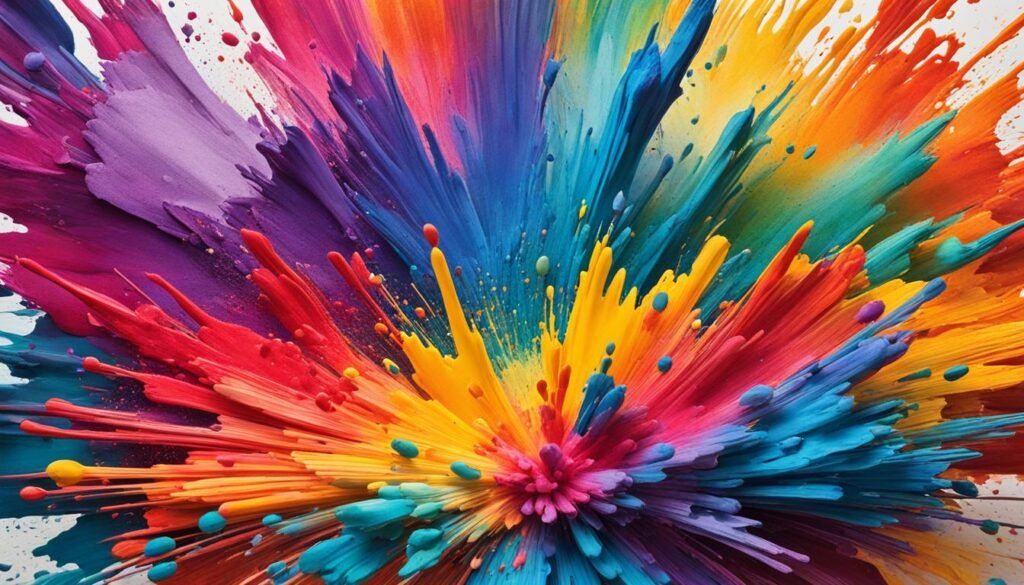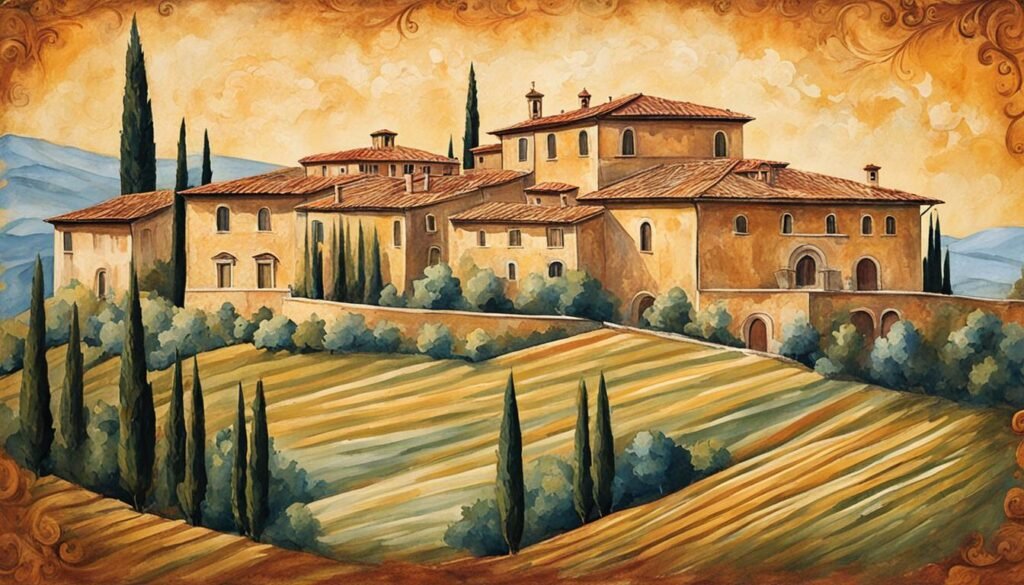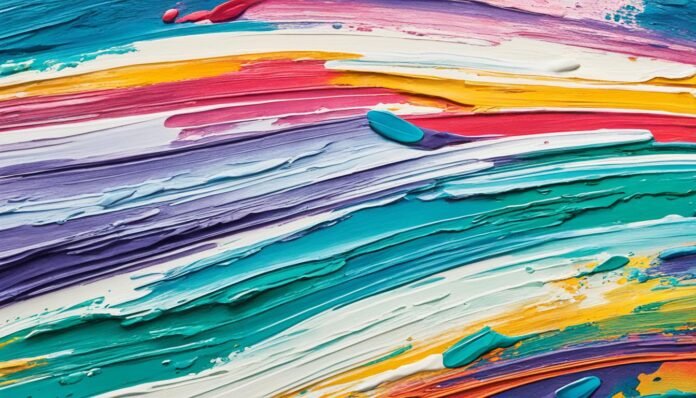Tempera paint has enchanted artists for centuries. This versatile medium offers a unique link to artistic history. Its vibrant technique continues to inspire creativity and innovation.
Tempera paint blends pigments with a binder, often egg yolk. It produces a rich, matte finish with diverse expressive possibilities. Artists can create luminous, translucent layers or bold, impasto strokes.
Explore the fascinating history of tempera paint. Uncover the secrets of Renaissance masters who mastered this timeless medium. Learn about traditional pigments and the modern revival of tempera.
This guide will help you unlock tempera paint’s magic. You’ll discover its potential to inspire your own artistic journey.
Key Takeaways
- Tempera paint is a versatile and vibrant painting medium with a rich history
- Tempera paint offers a wide range of expressive possibilities, from translucent glazing to bold impasto strokes
- The Renaissance masters were renowned for their masterful use of tempera paint
- Tempera paint is made with pigments and a binder, often egg yolk, creating a unique matte finish
- Tempera paint has undergone a resurgence in modern art, captivating a new generation of artists
What is Tempera Paint?
Tempera paint is a traditional artistic medium used for centuries. It’s a water-based paint made by mixing pigments with a binder, typically egg yolk. This combination creates a versatile and durable paint favored by many renowned artists.
History and Origins
Tempera paint has roots in ancient civilizations. Its use dates back to 5th century BC in Egypt, Greece, and Rome.
Over time, tempera painting techniques evolved. The iconic egg tempera formulation became popular during the Renaissance period.
Types of Tempera Paint
Egg tempera is the most well-known type of tempera paint. However, artists can explore several other variations.
- Gum tempera, which uses a gum-based binder
- Casein tempera, which uses a milk-based binder
- Glue tempera, which uses a glue-based binder
- Oil tempera, which combines tempera with oil-based paints
Each tempera paint type offers unique characteristics and applications. Artists can select the medium that best suits their creative vision and painting style.
“Tempera painting is a unique and captivating medium that has inspired countless artists throughout history. Its rich history and diverse formulations make it a truly versatile and fascinating choice for both traditional and modern painters.”
The Renaissance Masters and Tempera Paint
The Renaissance period saw tempera paint’s comeback. Many famous artists used this versatile medium. Renaissance masters like Michelangelo, Raphael, and Botticelli created timeless works with tempera.
Tempera’s rich pigments and quick-drying nature suited Renaissance artists perfectly. It allowed for precise layering and glazing techniques. This helped them achieve their unique styles and render subjects clearly.
Tempera paint used egg yolk as a binder. This gave colors exceptional depth and luminosity. Such qualities elevated the artistic vision of Renaissance painters.
| Artist | Renowned Tempera Paintings | Artistic Technique |
|---|---|---|
| Michelangelo | The Sistine Chapel Ceiling | Intricate layering and glazing with tempera |
| Raphael | The Madonnas | Vibrant tempera pigments and detailed brushwork |
| Botticelli | The Birth of Venus | Exceptional use of tempera to capture delicate details |
“Tempera painting was the perfect medium for the Renaissance artists, allowing them to capture the essence of their subjects with unparalleled precision and luminosity.”
Tempera paint’s use by Renaissance masters has greatly influenced the art world. It continues to inspire artists to explore its unique qualities.
Tempera Paint Pigments and Binders
Tempera paint blends unique pigments and binders, giving it a distinct character. Let’s explore the traditional pigments and egg yolk’s role as a primary binder in tempera paint.
Traditional Pigments
Artists use a rich palette of traditional pigments in tempera paint. These natural pigments offer a wide range of hues with exceptional luminosity and durability.
Common tempera pigments include:
- Ochres: earthy pigments derived from iron oxides, providing a range of warm, earthy tones
- Cinnabar: a vibrant red pigment made from mercury sulfide
- Ultramarine: a deep blue pigment obtained from the semi-precious stone lapis lazuli
- Verdigris: a striking green pigment created from the corrosion of copper
Egg Yolk as a Binder
Egg yolk is the key binder in tempera paint, used for centuries. It combines finely ground pigments with its emulsifying properties, creating a vibrant and durable medium.
The egg tempera technique adds unique luminosity and transparency to the paint. This makes it a favorite choice among artists throughout history.
| Pigment | Color | Source |
|---|---|---|
| Ochre | Warm, earthy tones | Iron oxides |
| Cinnabar | Vibrant red | Mercury sulfide |
| Ultramarine | Deep blue | Lapis lazuli |
| Verdigris | Striking green | Copper corrosion |
Traditional pigments and egg yolk binder give tempera paint its unique qualities. This combination makes it a versatile and captivating medium for artists to explore.

Preparing and Working with Tempera Paint
Tempera painting requires understanding how to prepare and use this versatile medium. The key is achieving the right consistency. By mixing pigments and binders carefully, you can unlock tempera’s full potential.
Mixing and Consistency
Tempera paint needs a thoughtful mixing approach. It requires a balance between pigments and egg yolk binder. The consistency should be creamy, smooth, and thick for precise control.
Start by mixing pigment with egg yolk binder thoroughly. Add small amounts of water gradually, stirring constantly. The ideal consistency may vary based on the pigment and desired effect.
| Mixing Technique | Ideal Consistency |
|---|---|
| Thorough blending of pigment and egg yolk | Creamy, smooth, and spreadable |
| Gradual addition of water, with continuous stirring | Thick, but still easily applicable |
Proper consistency is crucial for successful tempera painting. Well-mixed paint allows for various techniques, from delicate glazes to bold strokes. Mastering this aspect unlocks tempera’s full artistic potential.
Techniques for Painting with Tempera
Tempera paint offers artists a wide range of techniques to explore. From delicate glazing to bold impasto strokes, this versatile medium allows for diverse creative expression.
Glazing with Tempera
Glazing involves applying thin, transparent layers of tempera paint. This method builds subtle color variations and creates depth. Artists can achieve a luminous quality by controlling the opacity of layers.
Impasto Technique
The impasto technique uses thick, textured layers of tempera paint. This bold approach adds depth and energy to artwork. Artists can sculpt the paint with palette knives or fingers for striking textures.
Mastering these techniques requires patience and experimentation. Artists can unlock creative possibilities by exploring the versatility of tempera paint. From refined glazing to powerful impasto, tempera offers endless artistic potential.
| Technique | Description | Effect |
|---|---|---|
| Glazing | Applying thin, transparent layers of tempera paint | Luminous, ethereal quality, depth, subtle color variations |
| Impasto | Applying thick, textured layers of tempera paint | Depth, energy, expressive brushstrokes, visual texture |
Tempera Paint and Frescoes
Tempera paint has a long history with fresco painting. It’s often used as a preparatory layer. This connection highlights the versatility of both painting techniques.
Tempera paint’s properties make it ideal for fresco work. It dries fast and sticks well to plaster or stone surfaces. Artists can build up paint layers without damaging the base.
Tempera’s matte finish creates a perfect foundation for the final fresco layer. This ensures a cohesive and striking visual outcome.
Many famous medieval and Renaissance artists combined tempera and fresco. Giotto, Michelangelo, and Raphael used tempera paint as a prep layer. It helped them achieve intricate details before applying fresco layers.
| Technique | Characteristics |
|---|---|
| Tempera | Fast-drying, matte finish, excellent adhesion to plaster or stone |
| Fresco | Pigments applied directly to wet plaster, durable and long-lasting |
The link between tempera paint and fresco painting still fascinates art lovers. It shows the timeless appeal of these two captivating mediums.

“Tempera paint served as the perfect foundation for the application of fresco, allowing artists to create intricate details and precise color blending before the final layer was applied.”
Comparing Tempera to Other Mediums
Tempera paint is a versatile medium with unique traits. It differs from encaustic and gouache in several ways. Understanding these differences helps artists choose the right medium for their work.
Tempera vs. Encaustic
Tempera and encaustic have ancient roots but use different binders. Tempera uses egg, while encaustic uses wax. This leads to different application methods and visual results.
Tempera dries to a matte, chalky finish. Encaustic, however, has a glossy, sculptural look. Tempera is more transparent, allowing for layering. Encaustic is more opaque and textural.
Tempera vs. Gouache
Gouache and tempera are both water-based paints with matte finishes. They’re known for their versatility in use. Tempera is more durable and permanent than gouache.
Gouache can fade and reactivate with water. Tempera offers more pigment choices, including earth tones. Gouache often has a limited, modern color palette.
| Characteristic | Tempera Paint | Encaustic | Gouache |
|---|---|---|---|
| Binder | Egg Yolk | Wax | Gum Arabic |
| Finish | Matte, Chalky | Glossy, Sculptural | Matte, Opaque |
| Layering | Transparent, Glazing | Opaque, Textural | Opaque, Reactivates with Water |
| Pigment Range | Extensive, including Earth Tones | Limited | More Limited, Modern Colors |
| Durability | Durable, Long-Lasting | Durable, Long-Lasting | Less Durable, Subject to Fading |
Knowing the properties of tempera paint, encaustic, and gouache helps artists make smart choices. Each medium has its strengths. Artists can pick the best tool for their creative vision.
The Resurgence of Tempera Paint
Tempera paint has made a comeback in recent years. Contemporary artists are rediscovering its timeless appeal. This revival stems from a growing appreciation for traditional techniques and the medium’s unique qualities.
The renewed interest in tempera paint is driven by its distinctive features. It creates rich, luminous colors and a matte, eggshell-like finish. This lends depth and texture to artwork, setting it apart.
Artists in modern art are drawn to tempera’s interaction with light. It produces a stunning visual effect that enhances their work. The medium’s ability to capture light is truly captivating.
“Tempera paint allows me to achieve a level of depth and detail in my paintings that simply isn’t possible with other mediums. The way it dries to a matte finish and captures the light is truly mesmerizing.”
The resurgence of tempera paint reflects a broader trend in art. Artists are exploring historical techniques and materials. They’re rediscovering the timeless appeal of mediums used by masters throughout the centuries.
- The rich, luminous colors of tempera paint have captivated a new generation of artists
- The medium’s unique matte finish and interaction with light creates a distinctive aesthetic
- Contemporary artists are drawn to the historical significance and traditional techniques of tempera painting
The modern art scene continues to embrace tempera paint. Its newfound popularity highlights its enduring appeal. This versatile medium promises to inspire artists for years to come.
Tempera Paint in Modern Art
Tempera paint continues to inspire modern and contemporary artists. This versatile medium has found new life in innovative creators’ hands. They’ve pushed the boundaries of what tempera paint can do.
Jacob Lawrence, an American artist, used tempera paint in his iconic Migration Series. His paintings depicted the Great Migration of African Americans. Lawrence’s use of tempera created a rich, textural quality in his work.
British artist Tracey Emin has embraced tempera paint in her bold mixed-media works. She combines tempera with collage and textiles. Emin creates personal pieces exploring identity, memory, and human experiences.
Tempera paint’s resurgence in modern art shows its enduring appeal. Artists keep experimenting with this versatile material. The ancient medium still offers much to the modern creative mind.
| Artist | Artwork | Tempera Techniques Used |
|---|---|---|
| Jacob Lawrence | The Migration Series | Layering, Glazing |
| Tracey Emin | My Bed | Mixed-Media, Impasto |
“Tempera paint allows me to create works that are both bold and delicate, capturing the complexities of the human experience.”
– Tracey Emin, British Artist
Tips and Tricks for Tempera Painting
Tempera painting offers a rewarding journey for artists. We’ve gathered valuable tips to boost your tempera paint techniques. These will help you navigate this medium with confidence.
Choose high-quality, pure pigments for vibrant, long-lasting results. Try different binders like egg yolk or casein. This will help you find the perfect consistency for your style.
- Invest in a range of brushes, from fine-tipped to broad, to allow for a diverse array of brushstrokes and textures.
- Embrace the unique characteristics of tempera paint, such as its matte finish and quick drying time. Leverage these qualities to create captivating layers and glazes.
- Familiarize yourself with the process of impasto, where you can build up thick, textured applications of tempera paint for added depth and visual interest.
Be aware of tempera paint’s drying time. Plan your painting process carefully. Avoid overworking the surface to prevent brittleness.
“The beauty of tempera paint lies in its versatility and the unique challenges it presents. Embrace the process, experiment, and let your creativity shine through.”
Use these tips to unlock new artistic possibilities. You’ll create stunning, enduring works of art with tempera paint.
Where to Find Tempera Paint Supplies
Finding the right tempera paint supplies is key for artists exploring this medium. Many brands and retailers offer high-quality paints, pigments, and binders. You can easily find essential materials for your tempera painting journey.
Online art supply stores like Blick Art Materials and Jerry’s Artarama are great resources. They offer a wide range of tempera products at competitive prices. These stores also provide convenient shipping options for artists.
Local art supply shops often stock various tempera paint products too. These stores let you examine materials in person before buying. This hands-on approach can help you choose the best supplies for your needs.
Art classes and workshops focused on tempera painting can be informative. Experienced instructors often share valuable insights about recommended brands. They can guide you to find the best quality paints and materials for your artistic style.

